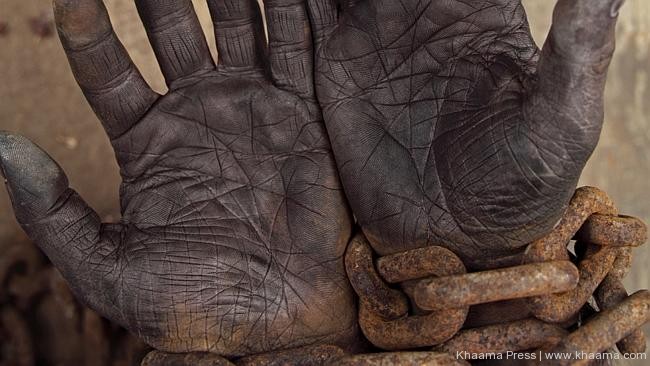If you thought that slavery was a concept that died a natural death or that we lived in more civilized times now, you would be wrong. There are still human beings living and working in wretched conditions, bonded labour is alive and well, human trafficking is a sickening and undeniable reality. And we Indians have much to be ashamed of when it comes to slavery as well.
Modern slavery

Image Source
Slavery today may not feature the extent of bondage, starvation or imprisonment that we imagine as being associated with the concept of slavery of old, but it still features the grim realities of kidnapping, buying and selling of humans, forced labour, forced marriage, debt bondage, child labour and other horrific realities. The modern ‘slave’ may be forced to continue to remain in a situation because of extreme poverty, coercion, isolation, threats, violence, deception or the abuse of authority /power.
Modern slavery is prevalent in several industries such as garments and other manufacturing, technology, agriculture and food production, forced begging, domestic work and construction industries. The sex trade and drug trafficking also enslave humans. In some countries, children are forcefully employed in militaristic organisations.
Slavery in present day India

Image Source
Some form of slavery exists in as many as 167 countries around the world and India ranks a shameful No 4 in a global survey that measured slavery. North Korea, Uzbekistan and Cambodia are the worst offenders and Qatar follows India at no. 5 among the countries with the highest prevalence of modern slavery. Though slavery was abolished in India by the Slavery Abolishment Act, 1883 and even with the Bonded Labour (Prohibition) Act of 1976 the practice flourishes still.
India has the dubious distinction of having the highest number of human beings living in some form of slavery; a total of 18.35 million enslaved people. About 1.4% of our population lives in slavery like conditions in various legal and illegal activities. Forced begging, farming and agriculture, domestic work, prostitution, fishing, other types of manual labour and also some manufacturing industries exploit adults and children, force them to live in inhuman conditions, monitor and restrict their movements and effectively imprison them.
Indian ‘slaves’ are also exported to international markets for various purposes. Slavery is often a result of abduction, often across international borders, followed by the exchange of human beings for cash or kind and at times a result of money lender debts. Granite quarries are another area where slavery like conditions persist. There is also the fact that Indians face slavery conditions when they go aboard to areas such as the Middle East. Caste, gender inequality and endemic poverty only complicate matters further.
If these facts do not make us hang our heads in shame, there is a purely economic reason why these facts ought to trouble us. Multiple organisations have recognised the widespread existence of slavery in India and this could likely affect foreign investment. Many Indian companies indirectly sanction slavery or are negligent about weeding the practice out of their supply chains and manufacturing processes. Ethical businesses would hesitate to invest in a country with such a poor track record of slave citizens.
Author – Reena Daruwalla





